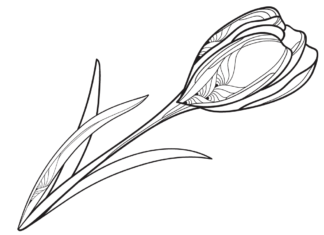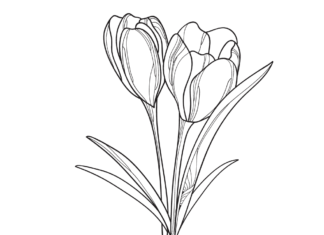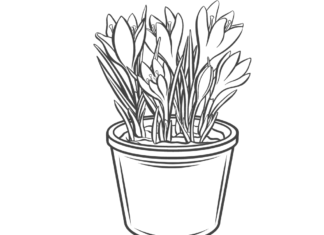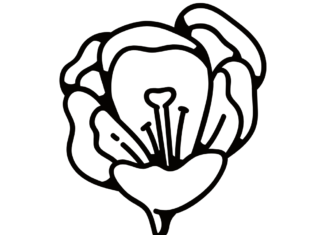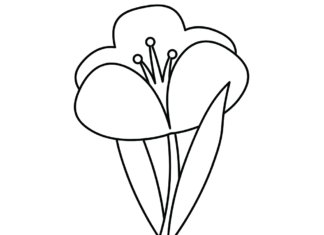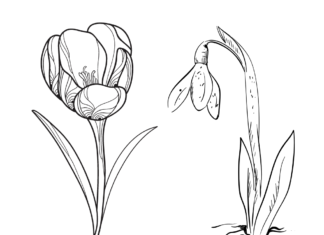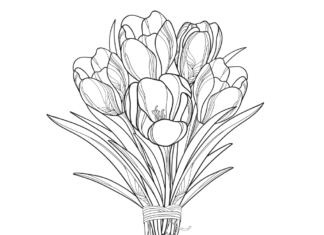Crocuses are popular and beautiful flowering plants, belonging to the lily family (Liliaceae) or scythe family (Iridaceae). They are known for their bright, colorful flowers that appear in early spring, often as the first signs of the arrival of warmer days after winter.
Crocus Coloring Pages
information
- Appearance: Crocuses have distinctive cup-shaped flowers with six petals in a variety of colors, such as purple, white, yellow and orange. The leaves of crocuses are narrow and lanceolate.
- Occurrence: Naturally, crocuses are mainly found in areas of Europe, Asia and North Africa. Many species of crocuses are grown as ornamental plants around the world.
- Flowering: Crocuses are typical spring flowering plants. They bloom depending on the species and variety, usually from March to May, depending on the climate and local conditions.
- Onions: Crocuses grow from bulbs that are stored underground. Crocus bulbs are extremely small compared to other bulbous plants.
- Early flowers: Crocuses are often considered the first flowers of spring, appearing while the snow is still melting. Their early flowering makes them highly prized as signs of the coming spring.
- Gardens and lawns: Crocuses are often planted in gardens and lawns, creating colorful carpets of flowers. They are also popular in parks, on embankments and other public spaces.
- Symbolism: Crocuses are a symbol of revival and rebirth because they bloom so early after winter. In some cultures, they are also considered symbols of joy and gladness.
- Use in folk medicine: In some regions, crocuses were used in folk medicine, and their extracts may have anti-inflammatory and sedative properties.
- Safran crocuses: Some species of crocus, such as the safran crocus (Crocus sativus), are cultivated for the extraction of the valuable spice saffron, which is used in cooking.
- Threat: Some crocus species are endangered as a result of environmental changes and over-harvesting for commercial purposes.
trivia
- Saffron Treasure: Safran crocus (Crocus sativus) is a source of the valuable spice saffron. Harvesting and processing saffron is labor-intensive, as it requires hand separation of the red, irritating thistles and flower stigmas. It is one of the most expensive spices in the world, due to the labor-intensive harvesting process.
- A symbol of mysticism: In ancient cultures such as Persia and Greece, crocuses were often associated with mythology and cults. In Greek mythology, a crocus was a young man in love with a nymph whose blood turned into the red stigma of a crocus flower.
- Crocuses and safran in the kitchen: The red stigmas of safran crocus are used in cooking to add flavor, color and aroma to dishes. Saffron is popular in Mediterranean, Indian and many other dishes.
- Diversity of species: There are many species of crocuses, but only a few are grown as ornamental plants. Some of these species are wild, while others are bred for their beautiful colorful flowers.
- Natural dyes: Safran crocus stigmata have been used for centuries as natural dyes for fabrics and textiles. The color pigment of safran is still used in some traditional crafts.
- Crocuses in literature: Crocuses often appear in literature and poetry, symbolizing spring, rebirth and beauty.
- Crocuses vs. honeybees: Early-blooming crocuses are a valuable food source for honey bees, which need nourishment in the early spring after the winter season.
- Crocuses in therapy: In some cultures, crocus has been used medicinally as an herb with analgesic and anti-inflammatory properties.
- Limited durability: Crocus flowers usually open only on sunny days and close overnight or on cloudy days, making them quite perishable.
- Variety of shapes: Although most crocuses have a similar flower shape, there are differences in the number and shape of petals and their arrangement.

